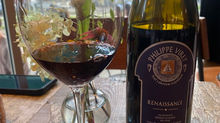Don't Let a Wine Label Intimidate You 🍷🥂 (how to read one).
- Lee Romano Sequeira
- Aug 23, 2023
- 2 min read

Decoding the language of wine labels can be intimidating, so let's break it down.
Here's what it all means:
✤ Name of the Wine: Let's begin with the obvious—the name of the wine. It could be a varietal like Chardonnay or Merlot, or a blend like a Cabernet-Syrah.
✤ Vintage: The year the grapes were harvested. Some years might produce exceptional wines due to weather conditions, while others could be more challenging.
✤ Producer and Winery: The winery or estate that crafted the wine. Some wineries are renowned for specific styles, so knowing the producer can give you an idea of what to expect.
✤ Region of Origin: Where the grapes were grown. Regions often have specific characteristics that influence the wine's taste. Bordeaux, Napa Valley, Burgundy—the list goes on.
✤ Appellation: A more specific sub-region within the larger wine region. Think of it as a neighborhood within the city, and this area can have a significant impact on the wine's character.
✤ Grape Variety: If it's a varietal wine, the label will mention the grape(s) used. This provides a clue about the wine's taste profile. Different grapes bring different flavors.
✤ Alcohol Content: The percentage of alcohol in the wine. This can give you a sense of how full-bodied or light the wine might be.
✤ Tasting Notes: Some labels offer brief descriptions of the wine's flavors and aromas. Look out for terms like "notes of cherry" or "hints of oak."
✤ Wine Type or Style: Labels might indicate if the wine is dry, sweet, sparkling, or fortified. This helps you match the wine to your taste preferences -- or, try something you've never tried before.
✤ Certification and Awards: If the wine is organic, biodynamic, or has won awards, you'll likely find it proudly displayed on the label.
✤ Importer Information: If the wine comes from another country, the label may mention the importer.
✤ Serving Recommendations: Some labels even suggest serving temperature and food pairings.
Reading a wine label is like opening a book filled with stories of geography, climate, and the winemaker's artistry.
So, next time you're in front of a bottle, take a moment to decode its label, and let your tasting adventure begin!

_edited.jpg)











































Comments